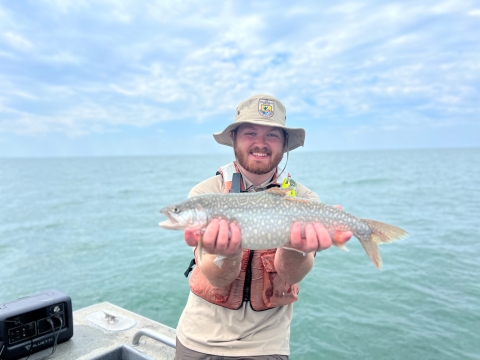About Us
We are working to restore lake sturgeon, lake trout and other native fish and their habitats in the Great Lakes, Finger Lakes, and the Allegheny River watersheds. We are also working to prevent the spread of invasive species invasive species
An invasive species is any plant or animal that has spread or been introduced into a new area where they are, or could, cause harm to the environment, economy, or human, animal, or plant health. Their unwelcome presence can destroy ecosystems and cost millions of dollars.
Learn more about invasive species in these watersheds and the New York State Canal System.
What We Do
The Lower Great Lakes Fish and Wildlife Conservation Office works to restore and protect the quantity and quality of habitat for fish within the Lake Erie and Lake Ontario watersheds. We restore important habitat and fish connectivity between streams, rivers and lakes. Our projects improve water quality, help increase abundance of fish, and sustain the economic and recreational benefits derived from fishing and recreating in our public waters.
Our Organization
Projects and Research
Our office consists of five primary programs: Native Species, Aquatic Invasive Species, and Aquatic Habitat Restoration. These programs are supported by the Science and Technology and Outreach and Education programs. We work with state and local partners to restore habitat for fish and wildlife. We also target habitat restoration at road-stream crossings which are subject to frequent flooding, and provide technical support in removing obsolete dams that are unsafe and barriers to fish passage fish passage
Fish passage is the ability of fish or other aquatic species to move freely throughout their life to find food, reproduce, and complete their natural migration cycles. Millions of barriers to fish passage across the country are fragmenting habitat and leading to species declines. The U.S. Fish and Wildlife Service's National Fish Passage Program is working to reconnect watersheds to benefit both wildlife and people.
Learn more about fish passage . We also work with the U.S. Army Corps of Engineers, U.S. Geological Service, Canada and tribal nations to study native Great Lakes fish and respond to new invasive species invasive species
An invasive species is any plant or animal that has spread or been introduced into a new area where they are, or could, cause harm to the environment, economy, or human, animal, or plant health. Their unwelcome presence can destroy ecosystems and cost millions of dollars.
Learn more about invasive species .
Visit Us
We are collocated at the Iroquois National Wildlife Refuge, where there are a variety of recreational opportunities, such as fishing, paddling, hiking, birding, and wildlife watching. Come visit us for some quality time outdoors or check out our 400 gallon freshwater tank at the Visitor Center located on Casey Road between Route 77 and Route 63.
Get Involved
Discover for yourself what tens of thousands of volunteers have learned: Volunteering for the U.S. Fish and Wildlife Service is fun and rewarding in many ways. Master new skills. Meet new friends. Enjoy a sense of accomplishment from doing your part to further wildlife conservation for the pleasure of generations to follow. Check out our station's latest volunteer opportunities on volunteer.gov. We can accommodate a few volunteers per season, whether they are official internships for school credit or just looking for the experience.
Location and Contact Information
- Lower Great Lakes Fish and Wildlife Conservation OfficeView Details1101 Casey Road Basom, NY 14013-9730

































